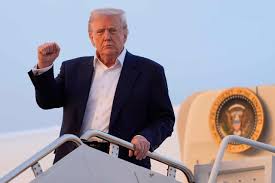U.S. President Donald Trump has ignited a global firestorm in the entertainment world with his latest proposal to impose a 100% tariff on films made outside the United States.
Initially announced on his Truth Social platform, Trump declared that he was authorizing the Commerce Department to begin the process of implementing the tax, claiming it was necessary because “America’s film industry is dying a very fast death.”
The move sent immediate shockwaves through both Hollywood and international production circles, raising concerns about the future of film production across borders.
In a fiery post, Trump framed the issue not just as an economic one, but a cultural and ideological battle. “It is, in addition to everything else, messaging and propaganda!” he wrote.
“WE WANT MOVIES MADE IN AMERICA, AGAIN!” The all-caps declaration echoed Trump’s familiar nationalist rhetoric, linking film production to broader themes of American identity and economic revival.
Commerce Secretary Howard Lutnick responded publicly, affirming, “We’re on it,” though details of the plan remain vague and undefined.
Despite the bold announcement, Trump appeared to backtrack slightly the following day. Speaking to reporters outside the White House, he suggested a more conciliatory approach. “I’m going to meet with the industry,” he said.
“We want to make sure they’re happy with what we’re proposing.” This shift seemed to acknowledge the immense backlash from Hollywood and global partners, who have pointed out that many American films are shot abroad for financial reasons and that the industry’s supply chains are deeply international.
Over the past two decades, filmmakers have increasingly turned to locations like the United Kingdom, Canada, Australia, and New Zealand to reduce production costs and tap into experienced international crews.
Major recent productions such as Deadpool & Wolverine, Wicked, and Gladiator II were all shot outside the U.S., despite being backed by American studios. The British Film Institute, responding to Trump’s remarks, stressed the importance of international cooperation in film.
“We want to keep collaboration at the heart of our sectors,” the organization said, noting that discussions with UK and US partners are already underway.
Questions continue to swirl around the specific details of Trump’s tariff proposal. Would the tax apply only to foreign films, or also to American studios that shoot abroad?
How would it affect streaming platforms like Netflix, whose content often straddles multiple countries? And crucially, what defines a “U.S. film”? Timothy Richards, founder of cinema chain Vue, posed these questions during an interview with BBC Radio 4: “Is it where the money comes from? .The script, the director, the talent, where it was shot?” he asked. “The devil will be in the details.”
The UK media union Bectu reacted swiftly, warning that such tariffs could “deal a knock-out blow” to the British film industry, which relies heavily on international partnerships.
Union head Philippa Childs urged the UK government to act. “The government must move swiftly to defend this vital sector, and support the freelancers who power it, as a matter of essential national economic interest.”
In response, the UK government reaffirmed its commitment to the creative sector, promising to unveil a new Creative Industries Sector Plan in the coming months.
Beyond the UK, countries like Australia and New Zealand are also closely monitoring the situation. Australia’s Home Affairs Minister Tony Burke stated, “Nobody should be under any doubt that we will be standing up unequivocally for the rights of the Australian screen industry.”
Similarly, New Zealand Prime Minister Christopher Luxon emphasized his government’s support for local producers. “We’ll be a great advocate, a great champion of that sector and that industry,” he told reporters, as uncertainty loomed over international production arrangements.
Film industry groups, including Screen Producers Australia, voiced concern over the possible implications of the tariffs.
“While there are many unknowns, there’s no doubt it will send shockwaves worldwide,” a representative said. These sentiments were echoed by industry analysts, who warned that retaliatory actions could follow.
NPR film critic Eric Deggans remarked, “It may create a situation where the tariffs in America are causing more harm than good. Other countries could respond with tariffs on U.S. films, limiting their global box office reach.”
Indeed, some retaliatory measures have already begun. In April, China announced a reduction in the number of American films permitted in its domestic cinemas, citing U.S. trade policies.
The China Film Administration issued a blunt statement: “The wrong action of the US government to abuse tariffs on China will inevitably further reduce the domestic audience’s favourability towards American films.”
The agency added that it would “moderately reduce” the number of U.S. films imported, based on market response and audience sentiment.
Since retaking office in January, Trump has pursued an aggressive tariff agenda aimed at boosting domestic manufacturing. He maintains that these economic measures are necessary to protect American jobs and industries.
“Tariffs are how we bring back our strength,” Trump has often said. However, economists and international observers warn that the global consequences are already being felt, with increased production costs and rising consumer prices in multiple sectors—including entertainment.
This isn’t Trump’s first attempt to shake up the film industry. Prior to his second inauguration, he appointed a trio of well-known actors—Jon Voight, Mel Gibson, and Sylvester Stallone—as “special ambassadors” tasked with reviving Hollywood.
“They will serve as Special Envoys to me for the purpose of bringing Hollywood, which has lost much business over the last four years to foreign countries, BACK—BIGGER, BETTER, AND STRONGER THAN EVER BEFORE!” Trump wrote at the time.
Yet, despite Trump’s ambitions to “Make Hollywood Great Again,” the reality of modern filmmaking is far more complex. According to industry research firm ProdPro, the U.S. still leads in global production spending, which totaled $14.54 billion in the last year.
However, that figure reflects a 26% drop from 2022, largely due to rising costs, labor disputes, and competition from other countries offering attractive incentives to filmmakers.
Streaming platforms have only further complicated the picture. With productions increasingly tailored for digital release, the boundaries between national cinemas have blurred
. Whether Trump’s proposed tariffs would include streamed content remains unclear, but many in the industry believe such a move would be difficult to enforce and likely to disrupt global distribution models that now rely heavily on cross-border collaboration.
For now, the Motion Picture Association, which represents the five major Hollywood studios, has remained silent. When contacted by the BBC, it declined to comment, perhaps waiting for more clarity before weighing in.
But behind closed doors, many executives are reportedly alarmed by the proposal and preparing contingency plans should the tariff be enforced.
Trump’s push for film tariffs marks a bold and controversial attempt to reshape one of America’s most iconic industries. Whether it results in a domestic renaissance or international backlash remains to be seen.
As the world awaits further details, one thing is clear: the intersection of politics, culture, and commerce has never been more volatile.










